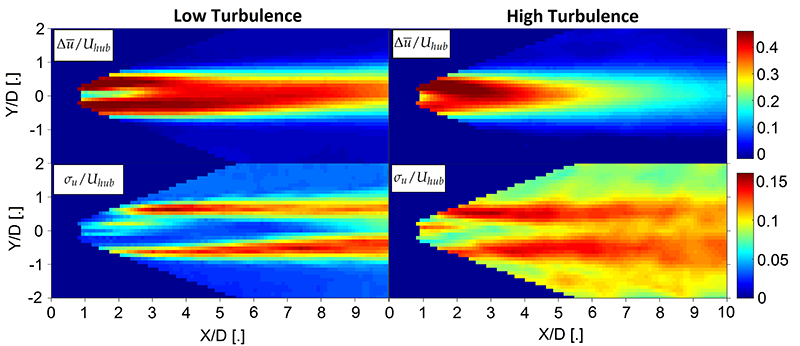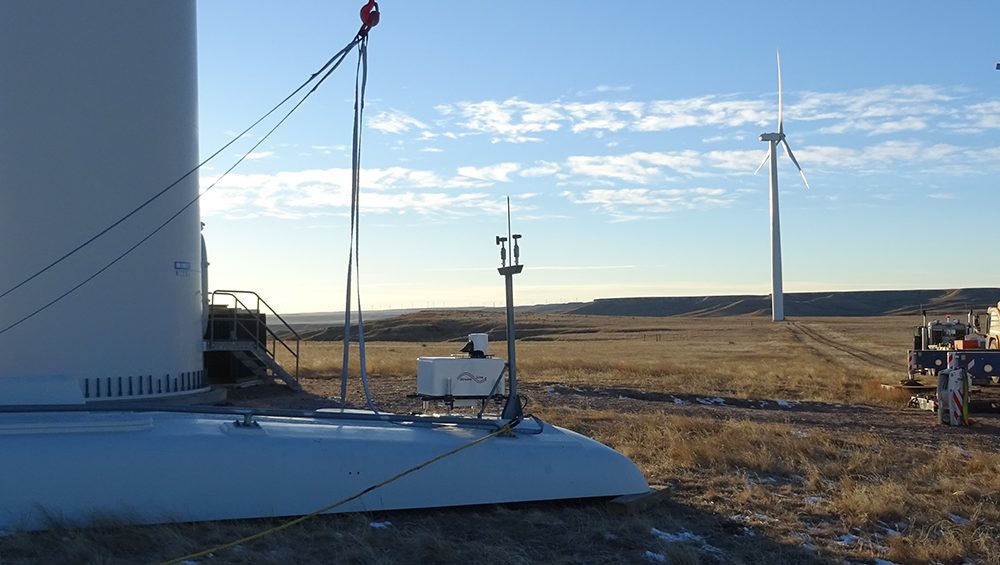The field experiments of the WiRE lab focus on measurements of the atmospheric flow around turbines using modern remote sensing instruments, an in-house UAV measurement platform, and in-situ instruments. Research topics currently investigated are the wake of yawed wind turbines, the influence of wind veer on the wake, and wake meandering. The WiRE lab also develops the methods required to carry out the aforementioned research.
Wake recovery
The wind turbine wake is a spatial volume of reduced velocity and increased turbulence downstream of a wind turbine. It can affect other turbines downstream negatively by decreasing their performance and durability. Field experiments of the WiRE lab showed the dependency of the wake recovery on the turbulence levels of the environment and quantified it (Fig. 1).

Active wake steering
Active wake steering or also known as active yaw control is a wind turbine control strategy with the aim to deflect the wake away from downstream turbines. A field test of active wake steering was conducted at a full-scale wind farm (Fig. 1 and Fig. 2). Results from this campaign showed that yawing a wind turbine deflects the wake as expected from modelling and highlighted the importance of precise and accurate wind direction measurements for the input of the yaw controller.


Wind veer affects span-wise cross section of the wake
The shape of the temporal-averaged wake is strongly influenced by a change of the wind direction with height, called wind veer, that is typical for the atmospheric boundary layer. Field experiments showed that prediction of an analytical model developed by WiRE [5] replicated the findings of the real world (Fig. 4).

References:
- [1] Carbajo Fuertes, F.; Markfort, C.D.; Porté-Agel, F. Wind Turbine Wake Characterization with Nacelle-Mounted Wind Lidars for Analytical Wake Model Validation. Remote Sens. 2018, 10, 668.
- [2] Brugger, P., Debnath, M., Scholbrock, A., Fleming, P., Moriarty, P., Simley, E., Jager, D., Roadman, J., Murphy, M., Zong, H., and Porté-Agel, F.: Lidar measurements of yawed-wind-turbine wakes: characterization and validation of analytical models, Wind Energ. Sci., 5, 1253–1272, https://doi.org/10.5194/wes-5-1253-2020, 2020.
- [3] Bastankhah, M., & Porté-Agel, F. (2016). Experimental and theoretical study of wind turbine wakes in yawed conditions. Journal of Fluid Mechanics, 806, 506-541. doi:10.1017/jfm.2016.595
- [4] Brugger, P.; Fuertes, F.C.; Vahidzadeh, M.; Markfort, C.D.; Porté-Agel, F. Characterization of Wind Turbine Wakes with Nacelle-Mounted Doppler LiDARs and Model Validation in the Presence of Wind Veer. Remote Sens. 2019, 11, 2247
- [5] Abkar, M.; Sørensen, J.N.; Porté-Agel, F. An Analytical Model for the Effect of Vertical Wind Veer on Wind Turbine Wakes. Energies 2018, 11, 1838.